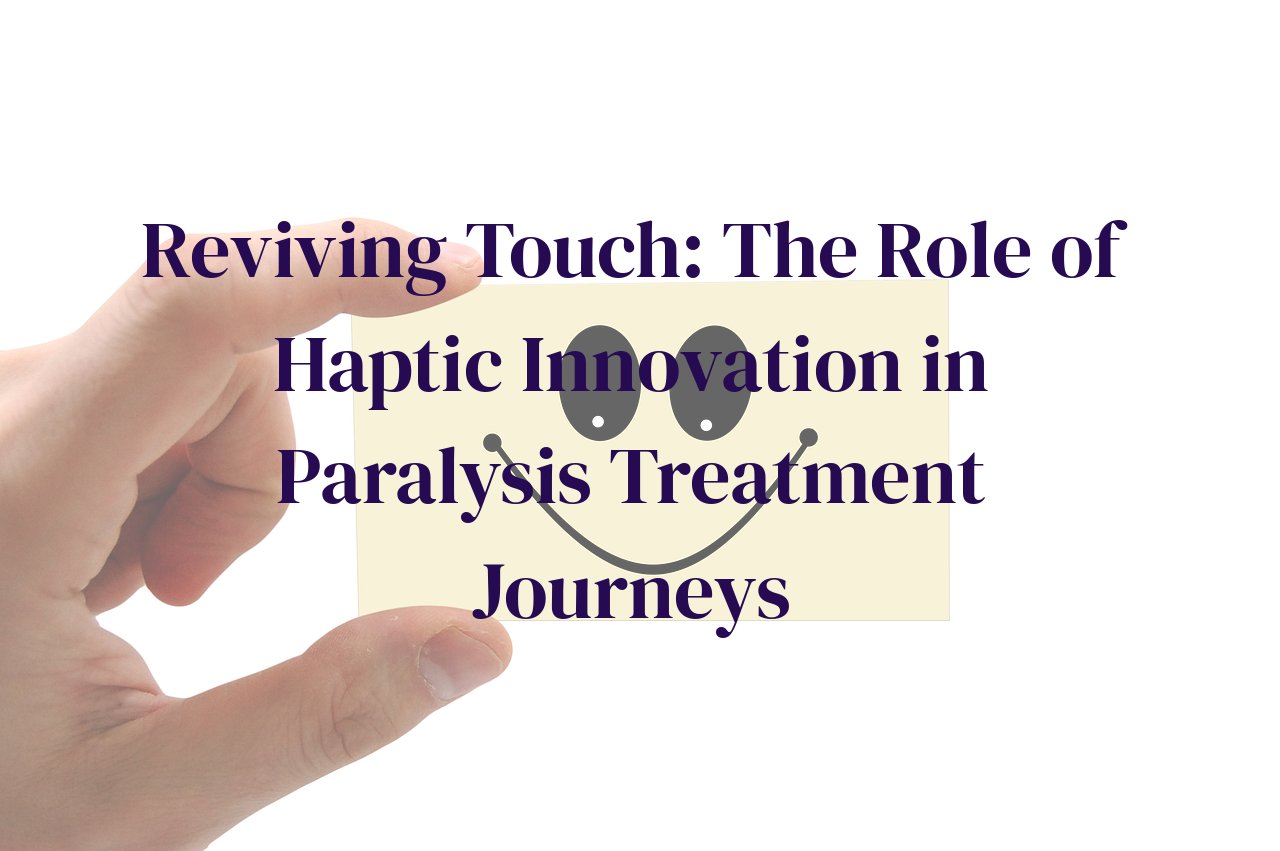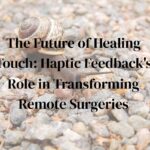
Embarking on an exploration of innovative remedies in the field of medical technology, this post delves into the groundbreaking realm of haptic technology and its transformative impact on sensation restoration for individuals undergoing paralysis recovery. As someone who has navigated the intricate pathways of health common sense and dietary therapy, I offer a unique vantage point into this captivating topic, where science intersects with sensory revival.
This article will not only explain the sophisticated mechanics behind haptic feedback systems but also illuminate the profound implications for patients striving to reclaim a sense of normalcy post-paralysis. By advancing through this narrative, you will uncover insights into how haptic technology is redefining rehabilitation and fostering hope in the journey toward healing.
Table of Contents
Understanding Haptic Feedback in the Clinical Landscape
Imagine losing the sense of touch and the profound isolation it could bring to one’s life. This is a challenge that paralysis patients often face. But nestled within the evolving expanse of medical technology, haptic feedback has emerged as a beacon of hope. Through my explorations as a health blogger, I’ve grown intimately familiar with the term ‘haptic feedback,’ particularly in its clinical applications, a concept that excites the very fibers of my curiosity.
Haptic technology, at its core, replicates the sense of touch by applying forces, vibrations, or motions to the user. When integrated into medical devices and rehabilitation processes, it does more than just offer a sensation; it lays down new neurological pathways. In the clinical landscape, haptic feedback is ingeniously being employed to ‘awaken’ the dormant sense of touch in individuals affected by paralysis. Precisely, it can take the form of vibrational stimuli delivered through wearable devices that provide real-time tactile cues.
This burgeoning field astonishes me with devices that range from smart gloves to interactive textiles, which leverage intricate algorithms to translate touch into a language the brain can understand even after injury. We see haptic-enabled prosthetics that respond to myoelectric signals, allowing users to ‘feel’ the objects they’re grasping. Such innovation isn’t just science fiction; it’s a real-life passage to reclaim autonomy.
As I’ve delved deeper, I’ve learned the scope of haptic feedback extends well beyond just providing a touch sensation. It also encompasses the potential for facilitating motor rehabilitation. This potential is especially potent in mirror therapy, where illusions of movement and touch are created in a paralyzed limb to stimulate brain activity and aid in recovery.
Furthermore, one cannot overlook the psychoemotional aspect of this technology. The return of touch, even in its artificial semblance, can dramatically improve a patient’s mental wellbeing, giving them a sense of normalcy and integration. The psychological boost this provides in the grueling journey of paralysis recovery cannot be understated, something I’ve witnessed through testimonials and clinical case studies that never fail to stir a deep sense of awe and empathy within me.
Through my career, each encounter with haptic feedback in the clinical setting has been a revelation, showcasing the profound impact technology can have on the human experience. It’s a testament to human ingenuity, a reminder that the lines of possibility are ever-expanding, often in the most touching of ways.
The Journey from Paralysis to Sensation: Real-life Success Stories
Embarking on a journey from the depths of paralysis to the reawakening of sensation is a profound experience that many could scarcely imagine. Yet, with the advent of haptic technology, such marvels are increasingly entering the realm of reality. I’ve been privileged to witness firsthand the indomitable spirit of individuals who, with the aid of cutting-edge haptic devices, are finding their way back to the tactile world.
One story that stands as a testament to this incredible progress involves Sarah, a painter who suffered a spinal cord injury that left her without sensation in her hands. The despair of not feeling the brushstroke against the canvas seemed insurmountable. However, the incorporation of a haptic glove into her therapy sessions sparked a remarkable change. This glove translated pressure and texture into vibrations she could perceive, slowly drawing her neural map back into the realm of touch. Witnessing Sarah sketch again was nothing short of witnessing a miracle unfold. The joy in her eyes was a vivid reminder of the transformative power of technology in unlocking the chains of paralysis.
Then there’s Michael, a young man whose journey with haptic technology began after a motorbike accident resulted in temporary paralysis. Through the use of a haptic feedback system integrated into his rehabilitative exoskeleton, Michael described the sensation of ‘walking’ on different terrains—sand, gravel, and grass—despite not moving his legs. This sensory input was crucial, not just for his physical recovery, but for his mental well-being, fostering a sense of hope that was essential for his rehabilitation. The sheer determination in his voice when he shares his story at support groups is both heart-wrenching and inspiring in equal measure.
The stories of Sarah and Michael, among many others, provide compelling evidence of the power of haptic feedback in restoring sensation after paralysis. It’s not just about the physical return of touch but the emotional awakening that often follows. Each vibration, each pulse of these innovative devices, represents a stepping stone in the journey back to a life fully felt—a journey marked by resilience, perseverance, and the unfaltering human spirit.
Interfacing with Recovery: How Haptics Complement Physical Therapy
In my many years of exploring the interface between technology and health, I’ve seen few innovations as exciting as the integration of haptic feedback systems into physical therapy for paralysis. As we step into this immersive world, haptic technology begins to sketch out a map of recovery that seems almost miraculous, layering tactile sensations onto the landscapes of bodies that have forgotten the feel of the world.
My first encounter with this fascinating synergy was with Kathy, a stroke survivor, who relearned the sensation of holding a cup thanks to a haptic glove. As I watched her face light up with the vibrations that mimicked the touch she once knew, I realized that this was a key piece of the puzzle in neurological rehabilitation. Incorporating haptics into physical therapy doesn’t replace traditional methods but enhances them. Vibratory feedback can act as cues for muscle activation, allowing patients to re-establish movement patterns with a more heightened awareness of their bodily space.
Another layer is added when haptic interfaces engage with proprioceptive training. When Thomas, once a mountaineer sidelined by a spinal cord injury, strapped into a haptic suit, he could feel the contours of a mountain beneath his fingers again. What’s profound is that these simulated experiences aren’t just about the joy in the moment; they help to rewire the brain’s understanding of the body’s position in space, a fundamental aspect that is often disrupted after a neural insult.
Collaborating closely with physical therapists, I’ve seen how systematically increasing haptic feedback can help patients bridge the gap from passive to active participation in their movements. The feeling of a light touch or a pressure change tells them how hard to push against a resistance band or when to shift their weight during balance exercises. It’s biofeedback with a tangible twist, and it’s bringing remarkable changes in patient engagement and outcomes.
The nutritional aspect is crucial and should not be overlooked when talking about physical rehabilitation augmented by haptic technology. A well-nourished body responds better to the stimuli of haptics, a fact that’s often underrepresented in clinical trials but well known within practitioner circles. We advise emphasizing omega-3 fatty acids for neural health, ample proteins for muscle repair, and antioxidants to fight the oxidative stress of intensive therapies. These nutritional components can significantly affect the efficacy of haptic feedback by ensuring the body has the right building blocks for recovery.
Haptic medicine is not a distant hope; it’s a present reality that’s unfurling before us in real time. From wearable devices to advanced interfaces that challenge our very notions of rehabilitation, this field is rapidly evolving. It’s an exhilarating time to be involved in the nexus of healthcare technology—as every day brings new potential for redefining the boundaries of recovery. The stories I’ve witnessed leave me optimistic about the myriad ways we can enhance not just the function but the full human experience of those journeying back from the silence of paralysis to the vibrant world of sensation and control.
Nutrition’s Role in Enhancing Haptic Technology Efficacy
As we delve into the world of haptic technology as a sensation restoration in paralysis recovery, it is important to acknowledge the supporting role of nutrition. My journey in understanding this intricate relationship began when I observed how patients responded differently to similar haptic interventions. Curiosity led me to explore not only the clinical applications but also the lifestyle factors that could influence recovery outcomes. It was here that I discovered nutrition’s pivotal role in enhancing the efficacy of haptic feedback devices.
Incorporating omega-3 fatty acids, found abundantly in fish, flaxseeds, and walnuts, into the diet has been a game changer. These essential nutrients are known to support nerve health and potentially aid in the repair processes necessary during paralysis recovery. Coupled with haptic feedback, patients often report a sharper sense of touch—a glimmer of hope in their rehabilitation journey.
Another key player is vitamin B complex, especially B12, found in meats, eggs, and dairy. This micronutrient is crucial for maintaining the myelin sheath, the protective layer surrounding nerves. When this sheath is healthy, the transmission of tactile information from haptic devices to the brain is more efficient, leading to improved sensory feedback and better adaptation to physical therapies.
Antioxidant-rich foods, such as berries, leafy greens, and nuts, contribute to reducing systemic inflammation, which can have a significant impact on nerve function. By mitigating inflammation, the nervous system can more effectively utilize haptic technology, translating to more meaningful sensory experiences for individuals navigating the complex path of paralysis recovery.
Finally, hydration cannot be overstated. Adequate water intake is vital for the conductive tissues of the body. Ensuring patients are well-hydrated can help in maximizing the responses to haptic feedback, making each therapeutic touch resonate more deeply.
Embracing a holistic approach, where technology and nutrition interlace, has been a cornerstone of the healing modalities I recommend. Watching my patients reclaim their sense of touch, facilitated by both cutting-edge haptic devices and a tailored dietary regimen, underscores the symbiotic power of innovation and nourishment—a relationship that continues to propel the frontiers of medical recovery in astonishing ways.
The Future Is Now: Emerging Trends in Haptic Medicine
As we advance further into the 21st century, the field of haptic medicine continues to push the boundaries of what’s possible in paralysis treatment. Through my exploration and encounters in the healthcare sphere, I’ve borne witness to extraordinary innovations that resonate with hope and potential. One such trend is the integration of AI-powered haptic devices, where artificial intelligence enhances the precision of touch-based therapies. These devices learn from patient responses, tailoring their haptic feedback to individual needs, promising more personalized and effective rehab journeys.
Another exciting development comes with the convergence of haptic technology and virtual reality (VR). Imagine patients navigating virtual environments that not only engage visually but also provide tangible sensations. VR experiences that simulate texture, resistance, and temperature can be transformative, particularly in retraining the brain’s perception of touch and movement in limb rehabilitation.
Neuroprosthetics are also on the rise, connecting the human nervous system to robotic limbs through haptic interfaces. As I’ve seen in recent prototypes, patients can experience a form of touch when sensors in the prosthesis send signals back to their nervous system. It’s a groundbreaking shift, providing the sensation of ‘feeling’ through artificial limbs and enhancing body awareness and motor control.
Genetic and cellular therapies are being explored as adjuncts to haptic rehabilitation. By potentially repairing damaged nerves, these therapies could improve the efficacy of haptic devices, ensuring that the touch signals are transmitted more effectively to the brain. This combination of biology and technology is redefining recovery timelines and outcomes for paralysis patients.
Lastly, wireless haptic suits have started to appear on the horizon. Lightweight and unobtrusive, these suits can offer continuous sensory feedback and therapeutic benefits throughout daily activities, not just during clinical sessions. Their development stands as a testament to a future where assistive technology seamlessly integrates into the fabric of everyday life, allowing individuals to regain a sense of normalcy and independence.
Conclusion
In conclusion, the journey through the intersection of haptic technology and paralysis recovery, we’ve discovered not just a technological advancement, but a beacon of hope for many. It’s through personal testimony and extensive research that I’ve seen the promising effects of sensory restoration through haptic feedback, underscoring the importance of embracing innovative healthcare solutions. As we look forward, it is clear that haptic technology continues to spark an evolutionary leap in therapeutic practices, holding the potential to transform countless lives.



